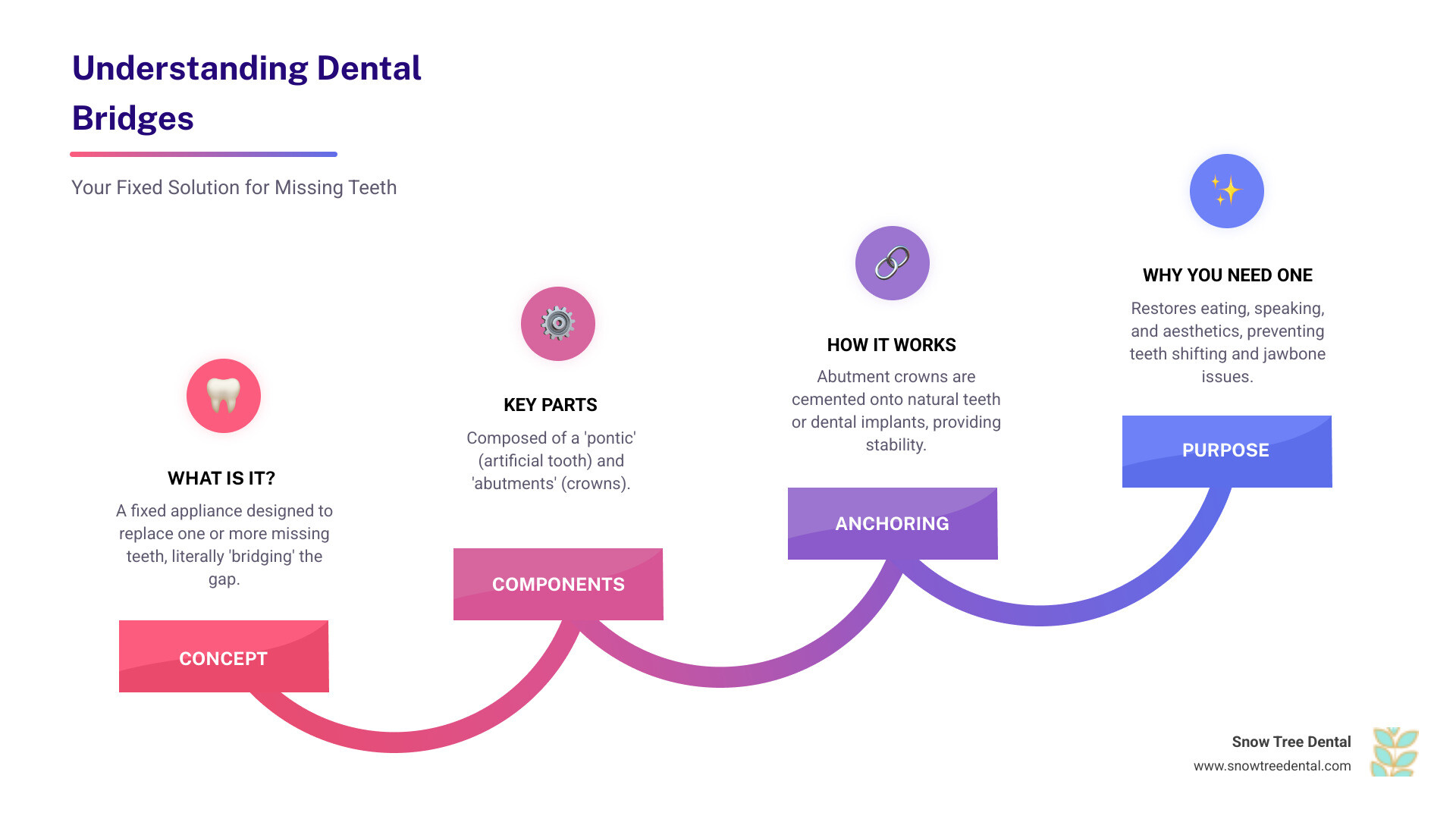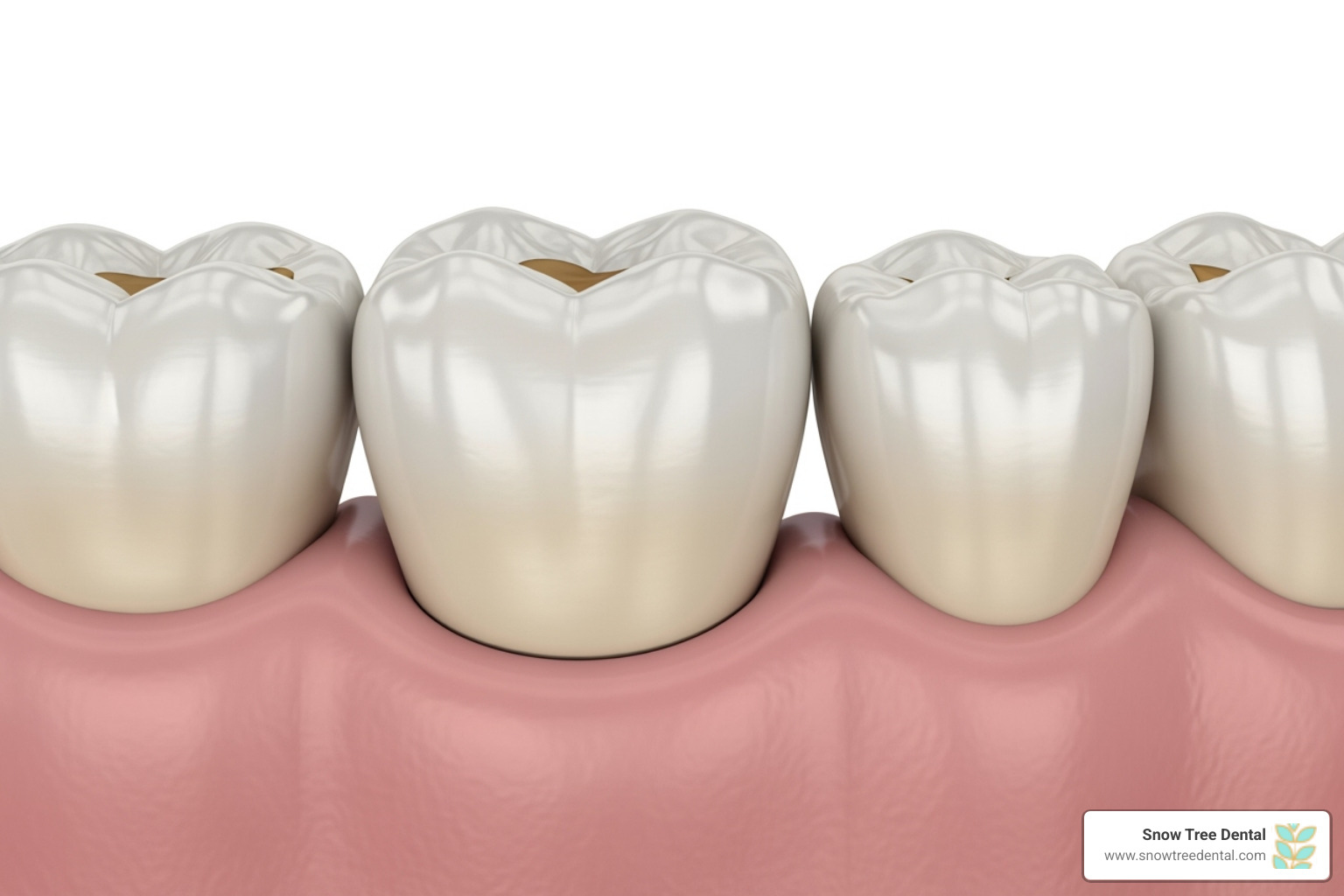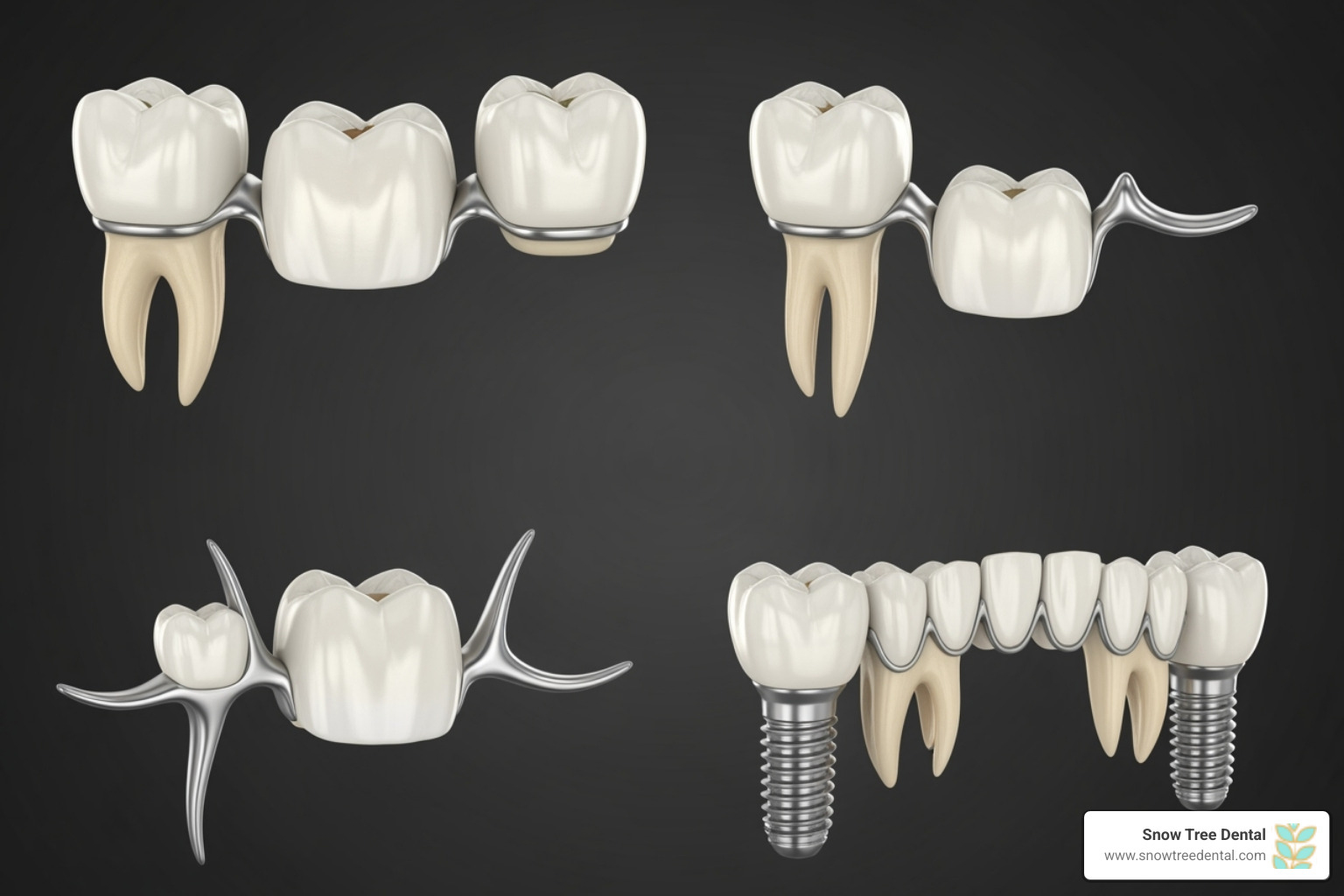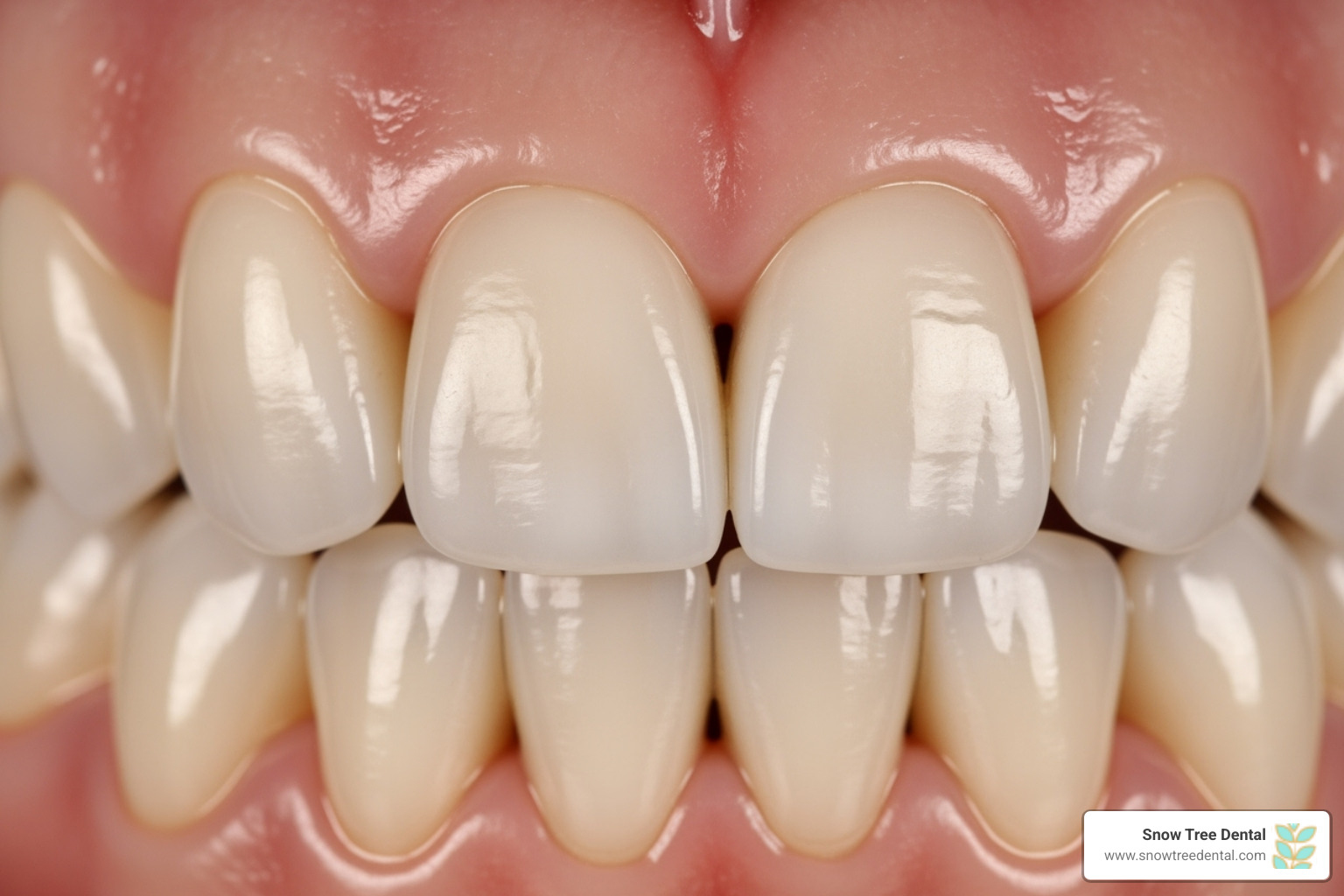Dental bridge Houston: 2025 Bright Smile
Finding the Right Dental Bridge Specialist in Houston
Dental bridge Houston providers offer a proven solution for replacing one or more missing teeth, restoring both function and confidence to your smile. Whether you’ve lost a tooth due to injury, decay, or gum disease, Houston dentists provide comprehensive bridge services to help you eat, speak, and smile naturally again.
When searching for a top-rated dental bridge specialist, it’s important to choose a practice that combines years of experience with modern technology, like the CEREC system for same-day restorations. At Snow Tree Dental, we pride ourselves on offering advanced, comfortable, and efficient treatments.
Average costs in Houston:
- Traditional 3-unit bridge: $1,500-$6,000
- Implant-supported bridge: $3,500-$11,000
- Most dental insurance covers 60-100% of bridge costs
A missing tooth isn’t just a cosmetic concern – it can cause your remaining teeth to shift, create bite problems, and lead to jawbone deterioration over time. The good news? Modern dental bridges can last 10-15 years with proper care, and our Houston practice offers same-day consultations with flexible scheduling and payment options.
I’m Dr. Muna Mohammad, and I’ve helped countless Houston families restore their smiles through personalized dental bridge Houston treatments at Snow Tree Dental. My experience with the latest bridge techniques and materials ensures you receive comfortable, long-lasting results that fit your budget and lifestyle.

What is a Dental Bridge and Why Do You Need One?
When you lose a tooth, it’s more than just a gap in your smile – it’s like losing a vital member of your oral health team. Every tooth has an important job, and when one goes missing, the others have to work overtime to compensate. That’s where a dental bridge Houston dentists recommend comes to the rescue.
A dental bridge is a fixed restoration that, as its name suggests, literally bridges the gap where your natural tooth used to be. This restoration consists of two main components that work together seamlessly. The pontic is the replacement tooth (or teeth) that fills your gap, while the abutments are specially designed crowns that fit over your natural teeth on either side of the space. These crowns act like strong pillars, holding your new tooth securely in place.

Here’s what many people don’t realize: leaving a missing tooth untreated creates a domino effect of problems throughout your mouth. Your remaining teeth, which were designed to work as a complete team, start shifting and tilting into that empty space. It’s like removing a player from a sports team – everyone else has to scramble to fill the gap, often creating chaos in the process.
This shifting leads to bite problems, uneven wear on your teeth, and jaw discomfort. The exposed gum tissue becomes a magnet for food particles and bacteria, increasing your risk of gum disease. Over time, you might even experience jawbone deterioration in the area where the tooth root used to stimulate healthy bone growth.
That’s why our team at Snow Tree Dental takes missing teeth seriously. Through our comprehensive General Dentistry Services, we evaluate not just the gap itself, but how it’s affecting your entire oral health picture.
The Main Benefits of Choosing a Dental Bridge
A dental bridge doesn’t just fill a space – it transforms your entire eating, speaking, and smiling experience. Your smile gets its sparkle back with a replacement tooth that matches your natural teeth so perfectly, even you might forget which one isn’t original. The confidence boost alone is worth celebrating.
Eating becomes enjoyable again when you can chew efficiently on both sides of your mouth. No more avoiding your favorite foods or dealing with embarrassing moments when something gets stuck in the gap. Your speech clears up too – no more lisping or whistling sounds that make you self-conscious during important conversations.
Your remaining teeth stay put because the bridge acts like a fence, preventing your natural teeth from wandering into the empty space. This keeps your bite properly aligned and distributes chewing forces evenly across all your teeth, protecting them from excessive wear and potential fractures.
Your face maintains its natural shape because the bridge supports your cheeks and lips from the inside. Without this support, your facial features can gradually sink inward, adding years to your appearance. The convenience factor is huge – unlike removable dentures, your bridge stays put 24/7, functioning just like your natural teeth with no daily removal routine required.
Are You a Good Candidate for a Dental Bridge?
Not everyone is an ideal candidate for a dental bridge, but many people are pleasantly surprised to learn they qualify. The key factors revolve around the health of your surrounding teeth and gums, plus your commitment to good oral care.
Your adjacent teeth need to be strong and healthy since they’ll be supporting your new bridge. Think of them as the foundation of a house – they need to be solid and decay-free to handle the extra responsibility. If these teeth have large fillings or previous root canal treatment, we’ll need to evaluate whether they can handle the additional load.
Healthy gums are absolutely essential for bridge success. Any signs of gum disease need to be treated first, because inflamed or infected gums can’t properly support a restoration. The good news is that most gum problems can be resolved with proper treatment before moving forward with your bridge.
Missing one to three consecutive teeth creates the ideal scenario for a traditional bridge. If you have gaps in different areas of your mouth, we might recommend multiple bridges or alternative treatments that better suit your specific situation.
Your overall oral health matters because we need to ensure your mouth can handle and maintain the restoration long-term. During your consultation, we’ll take X-rays and perform a thorough examination to assess your bone levels, bite alignment, and general oral condition.
Good daily oral hygiene habits are crucial for bridge longevity. If you’re committed to brushing, flossing (with special techniques we’ll teach you), and keeping up with regular dental visits, you’re setting yourself up for success. While being a non-smoker certainly helps with healing and long-term results, we work with patients in all situations to achieve the best possible outcomes.
Exploring the Types and Materials of Dental Bridges
When considering a dental bridge Houston, it’s helpful to understand that not all bridges are created equal. There are different types, each suited for specific situations, and a variety of materials used, impacting both durability and appearance. Our goal at Snow Tree Dental is to find the perfect fit for your smile, both functionally and aesthetically. We also offer a range of Cosmetic Dentistry Services to ensure your bridge blends seamlessly with your natural teeth.

The Four Main Types of Dental Bridges
Think of dental bridges like different tools in a toolbox – each one designed for a specific job. The type that’s right for you depends on your unique situation, from the location of your missing tooth to the health of your surrounding teeth.
The traditional dental bridge is by far the most popular choice, and for good reason. Picture two crowns acting like bookends, holding a replacement tooth securely in the middle. Your dentist will carefully prepare the teeth on either side of the gap by removing a small amount of enamel, then place crowns over these “abutment” teeth to anchor your new bridge. It’s incredibly strong and reliable – perfect for those back teeth that do the heavy lifting when you’re enjoying your favorite Houston barbecue.
Sometimes, you might only have a healthy tooth on one side of the gap. That’s where a cantilever bridge comes in handy. Think of it like a diving board – it extends from one supporting tooth to fill the space. While it’s a clever solution for specific situations, we typically reserve this option for areas with lighter biting forces, since all the pressure rests on that single supporting tooth.
For those who want to preserve as much of their natural tooth structure as possible, a Maryland bridge offers an neat solution. Instead of requiring full crowns on the adjacent teeth, this bridge uses a thin metal or porcelain framework that bonds to the back surfaces of your neighboring teeth. It’s like having wings that hold your replacement tooth in place. This conservative approach works beautifully for front teeth, where the biting forces are gentler.
When you’re missing several teeth in a row, an implant-supported bridge becomes the gold standard. Rather than relying on your natural teeth for support, this bridge anchors to dental implants surgically placed in your jawbone. It’s the strongest, most stable option available, and with proper care, it can last 35 years or more. Plus, it doesn’t require altering any of your healthy teeth – they get to stay exactly as nature made them.
Common Materials Used for Durability and Appearance
The material your bridge is made from plays a huge role in how it looks, feels, and performs over the years. At Snow Tree Dental, we take time to discuss these options with you, considering everything from your budget to your smile goals.
| Material | Description | Pros | Cons |
|---|---|---|---|
| Porcelain | Pure ceramic material that closely mimics natural tooth enamel | Excellent aesthetics, stain-resistant, biocompatible | More brittle than other options, higher cost |
| Zirconia | Advanced ceramic material known for exceptional strength | Extremely durable, natural appearance, metal-free | Premium pricing, limited repairability |
| Porcelain-Fused-to-Metal (PFM) | Metal framework covered with porcelain for aesthetics | Strong foundation with natural appearance, proven track record | Potential for metal show-through, may cause gum discoloration over time |
| Gold Alloys | Traditional metal option with excellent biocompatibility | Incredibly durable, gentle on opposing teeth, long-lasting | Obvious metallic appearance, higher material costs |
Porcelain remains the top choice for front teeth because it captures the translucent quality of natural enamel beautifully. When light hits a porcelain bridge, it behaves just like your real teeth, making it virtually impossible to tell the difference.
Zirconia has become increasingly popular as the “best of both worlds” material. It’s incredibly strong – some patients joke that it’s tougher than their original teeth – yet it maintains a natural, tooth-colored appearance. This makes it perfect for back teeth that need to withstand heavy chewing forces while still looking great.
Porcelain-fused-to-metal bridges offer a time-tested combination of strength and beauty. The metal core provides excellent durability, while the porcelain outer layer ensures your bridge looks natural. However, over time, you might notice a thin dark line near the gum line as the metal shows through.
Gold alloys might seem old-fashioned, but they’re actually incredibly gentle on your opposing teeth and can last decades. While the appearance isn’t for everyone, some patients love the distinctive look and appreciate knowing their bridge will likely outlast everything else in their mouth.
Alternatives to Dental Bridges
While bridges are an excellent solution, they’re not your only option for replacing missing teeth. Understanding all your choices helps ensure you make the best decision for your unique situation.
Dental implants represent the closest thing to getting your natural tooth back. A titanium post is surgically placed in your jawbone, then topped with a crown. Unlike bridges, implants don’t require altering adjacent teeth, and they actually help preserve your jawbone. The trade-off? They require surgery and a longer healing period, plus they typically cost more upfront.
Partial dentures offer a removable solution that can replace one or several missing teeth. They’re often the most budget-friendly option and don’t require any alteration of your existing teeth. However, they’re not as stable as bridges and need to be removed for cleaning and sleeping.
The choice between these options often comes down to your priorities. If you want something fixed in place that feels most like your natural teeth, a bridge might be perfect. If preserving your adjacent teeth is most important and you don’t mind a longer treatment process, an implant could be ideal. And if budget is your primary concern, a partial denture might be the way to go.
At Snow Tree Dental, we believe in taking the time to understand what matters most to you. Whether that’s getting back to eating your favorite foods quickly, maintaining your natural teeth, or finding a solution that fits your budget, we’ll help you weigh the pros and cons of each option to find your perfect match.



